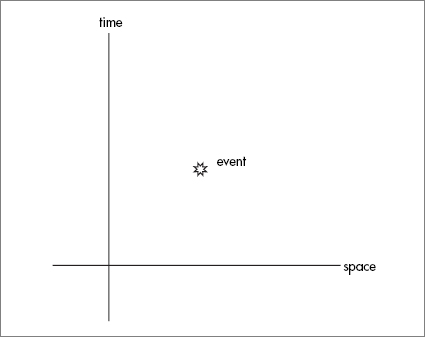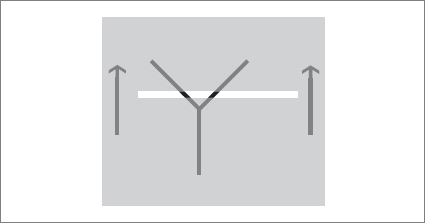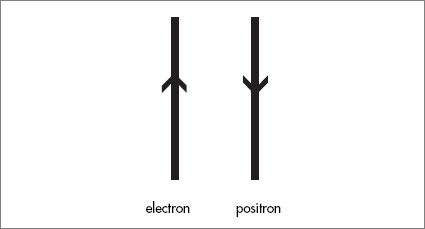The Cosmic Landscape (7 page)

A sheet of paper or a blackboard can be used to represent space-time. Because the paper or the blackboard has only two dimensions, we’ll have to cheat a bit. The horizontal direction on the paper will be a stand-in for all three directions of space. We will have to stretch our imagination and pretend that the horizontal axis is really three perpendicular axes. That leaves us with the vertical direction to represent time. The future is usually taken to be up and the past, down (that of course is just as arbitrary as the fact that maps place the northern hemisphere above the southern). A point on the sheet of paper is an event—a
where
and a
when:
a space-time point. This is where Feynman began: particles, events, and space-time.
Our first Feynman diagram depicts the simplest of all stage directions: “Electron, go from point a to point b.” To represent this graphically, draw a line on a piece of paper from event a to event b. Feynman also put a little arrow on the line whose purpose will become clear shortly. The line connecting a with b is called a
propagator.
The photon also can move from one space-time point to another. To depict the photon’s motion, Feynman drew another line, or propagator. Sometimes the photon propagator is drawn as a wavy line, sometimes as a dashed line. I will use the dashed line.
Propagators are more than just pictures. They are quantum-mechanical instructions for calculating the probability that a particle starting at point a will show up later at point b. Feynman had the radical idea that a particle doesn’t merely move along a particular path: in an odd way it feels out all paths—random zigzag paths as well as straight paths. We saw a bit of this quantum weirdness in the two-slit experiment. Photons don’t go through just the left slit or the right slit: they somehow sample both paths and in the process create the surprising interference patterns where they are detected. According to Feynman’s theory all possible paths contribute to the probability for the particle to go from a to b. In the end a particular mathematical expression representing all possible paths between the two points gives the probability to go from a to b. All of this is implicit in the notion of a propagator.



Nothing of very great interest would ever happen if all that ever took place were the free motion of electrons and photons. But they both take part in one coordinated action that is responsible for everything interesting in nature. Recall what happens when electrons move from one cloud to another during a lightning storm. Night suddenly turns into day. Light emitted by the sudden violent electric current dramatically illuminates the sky for an instant. Where does that light come from? The answer traces back to individual electrons. When the motion of an electron is suddenly disturbed, it may respond by shaking off a photon. The process, called
photon emission,
is the basic event of Quantum Electrodynamics. Just as all matter is built of particles, all processes are built from the elementary events of emission and absorption. Thus, the electron—while moving through space-time—can suddenly shoot out a single quantum (or photon) of light. All the visible light that we see, as well as radio waves, infrared radiation, and X-rays, is composed of photons that have been emitted by electrons, either in the sun, the filament of a lightbulb, a radio antenna, or an X-ray machine. Thus, Feynman added to the list of particles a second list: a list of elementary events. This brings us to a second kind of Feynman diagram.
The Feynman diagram representing the event of photon emission is called a
vertex diagram.
A vertex diagram looks like the letter Y, or better yet, a forked road: the original electron comes to the fork and shoots off a photon. Subsequently, the electron takes one path, and the photon, the other. The point where the three lines join—the event that emits the photon—is the vertex.
Here is a way to view a Feynman diagram as a short “movie.” Get a square of cardboard a few inches on a side and make a long thin slit about one sixteenth of an inch wide. Now place the square over the Feynman diagram (first fill in the dashed lines) with the slit oriented in the horizontal direction. The short line segments showing through the slit represent particles. Start the slit at the bottom of the diagram. If you now move the slit up, you will see the particles move, emit, and absorb other particles and do all the things that real particles do.



The vertex diagram can be turned upside down (remember, past is down, and future is up) so that it describes an electron and a photon approaching each other. The photon gets absorbed, leaving only the lone electron.
Feynman had a purpose in mind when he put little arrows on the electron lines. Each type of electrically charged particle, such as the electron and proton, has a twin, namely, its antiparticle. The antiparticle is identical to its twin, with one exception: it has the opposite electric charge. When matter meets antimatter, look out! The particles and antiparticles will combine and disappear (annihilate), but not without leaving over their energy in the form of photons.
The antiparticle twin of the electron is called the positron. It appears to be a new addition to the list of particles, but according to Feynman, the positron is not really a new object: he thought of it as an electron
going backward in time!
A positron propagator looks exactly like an electron propagator except that the little arrow points downward toward the past instead of upward toward the future.
Whether you think of a positron as an electron going backward in time or an electron as a positron going backward in time is up to you. It’s an arbitrary convention. But with this way of thinking, you can flip the vertex in new ways. For example, you can flip it so that it describes a positron emitting a photon.


You can even turn it on its side so that it shows an electron and a positron annihilating and leaving only a single photon or a photon disappearing and becoming an electron and a positron.

